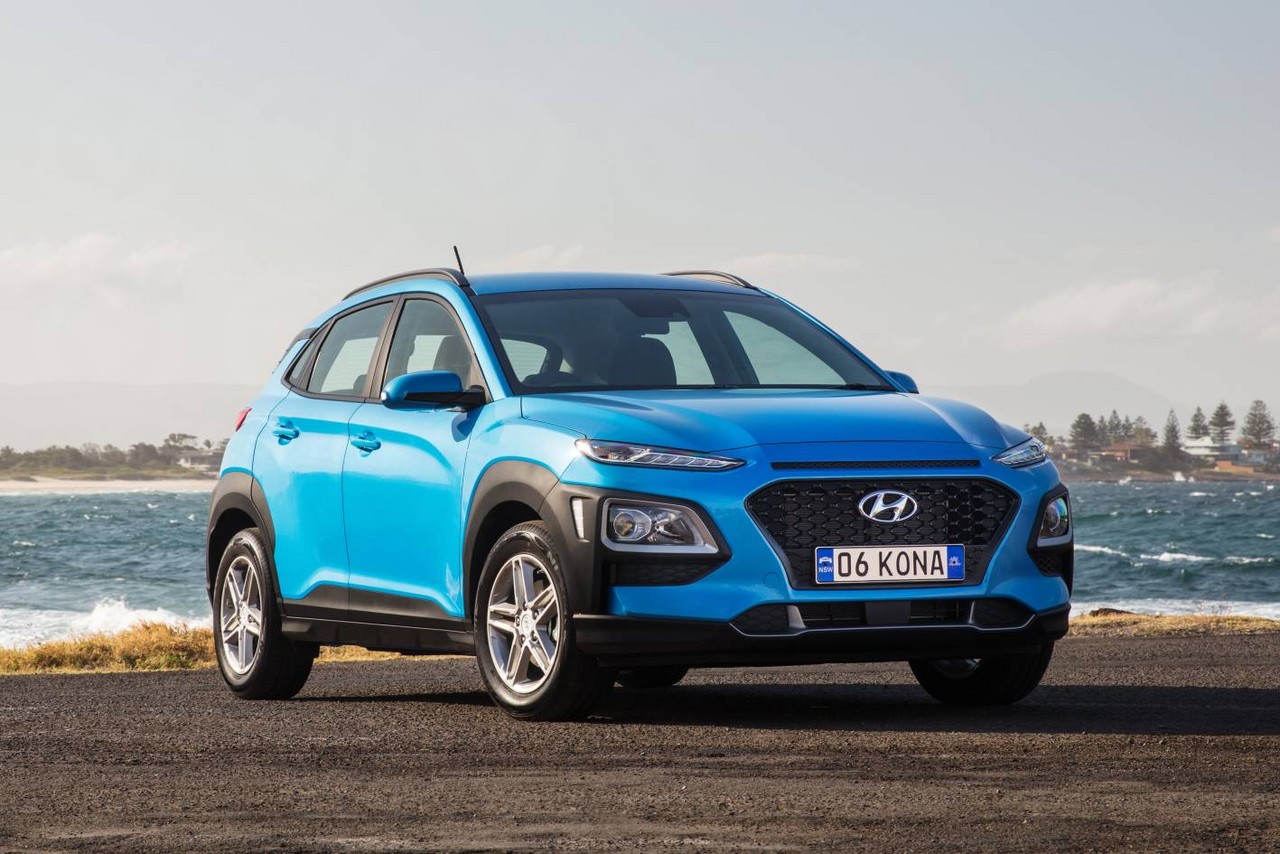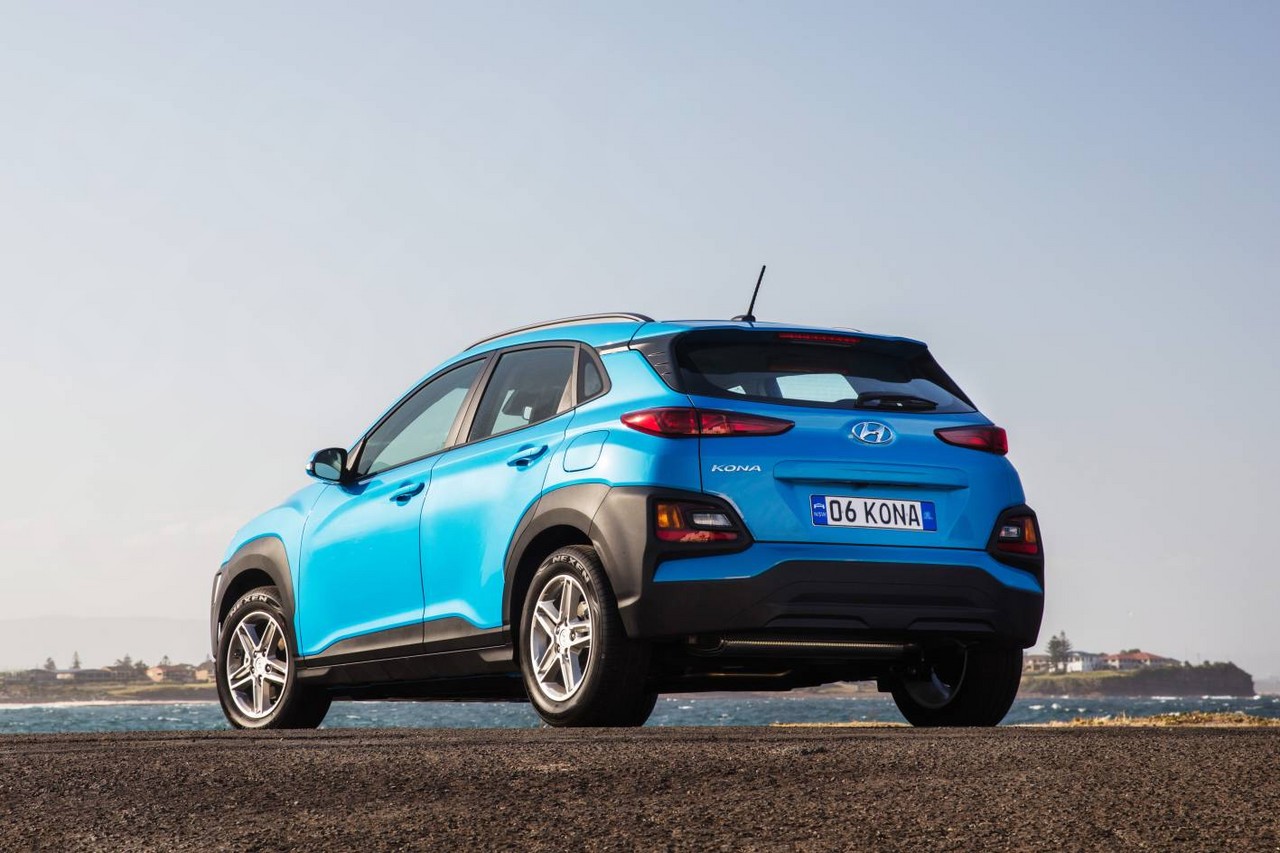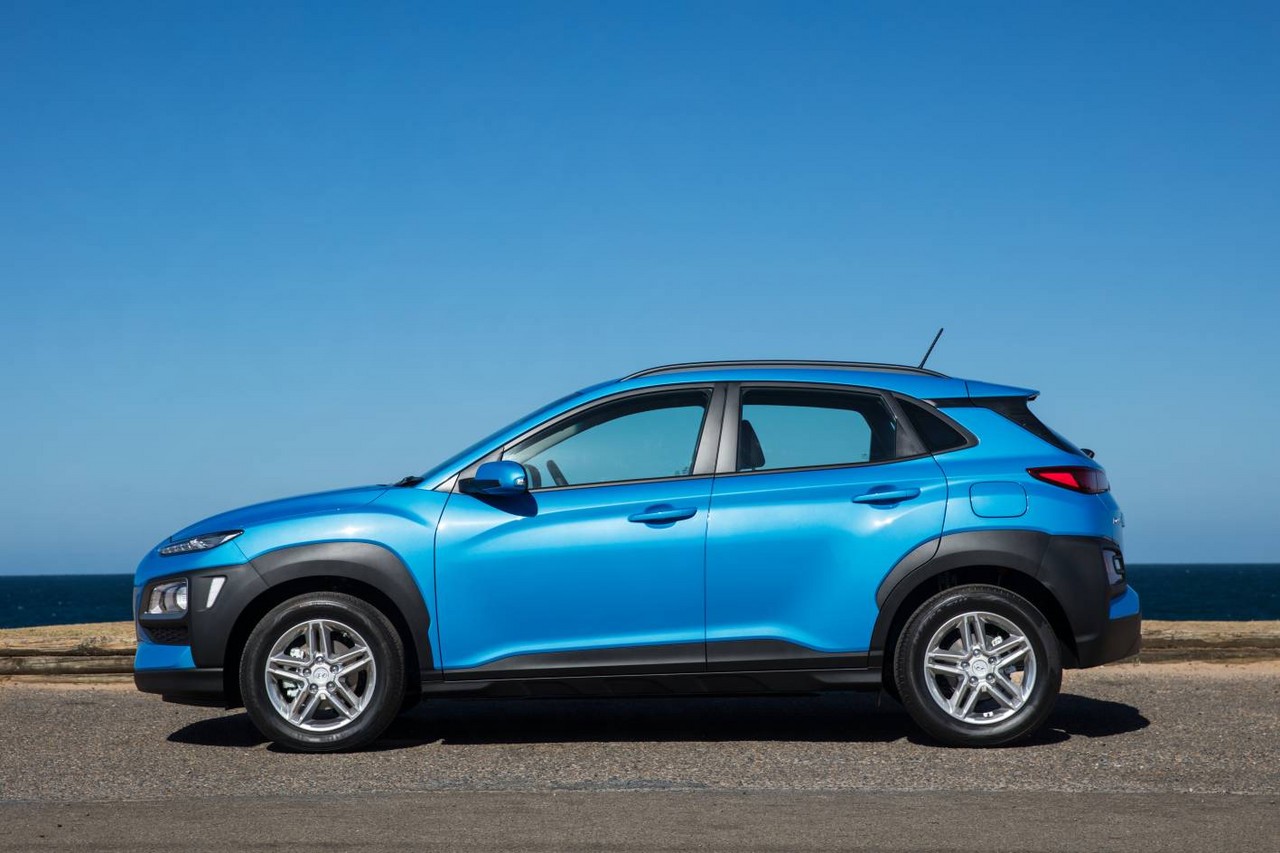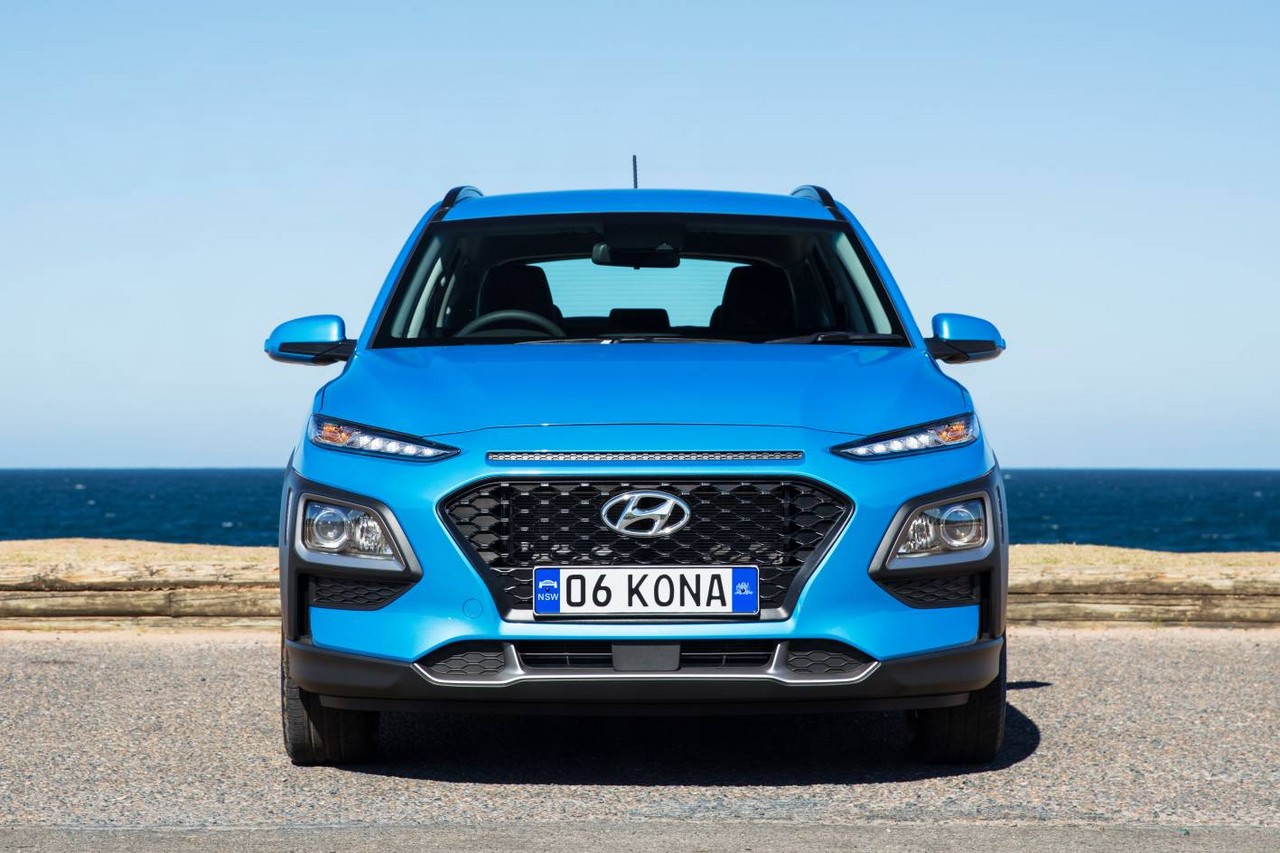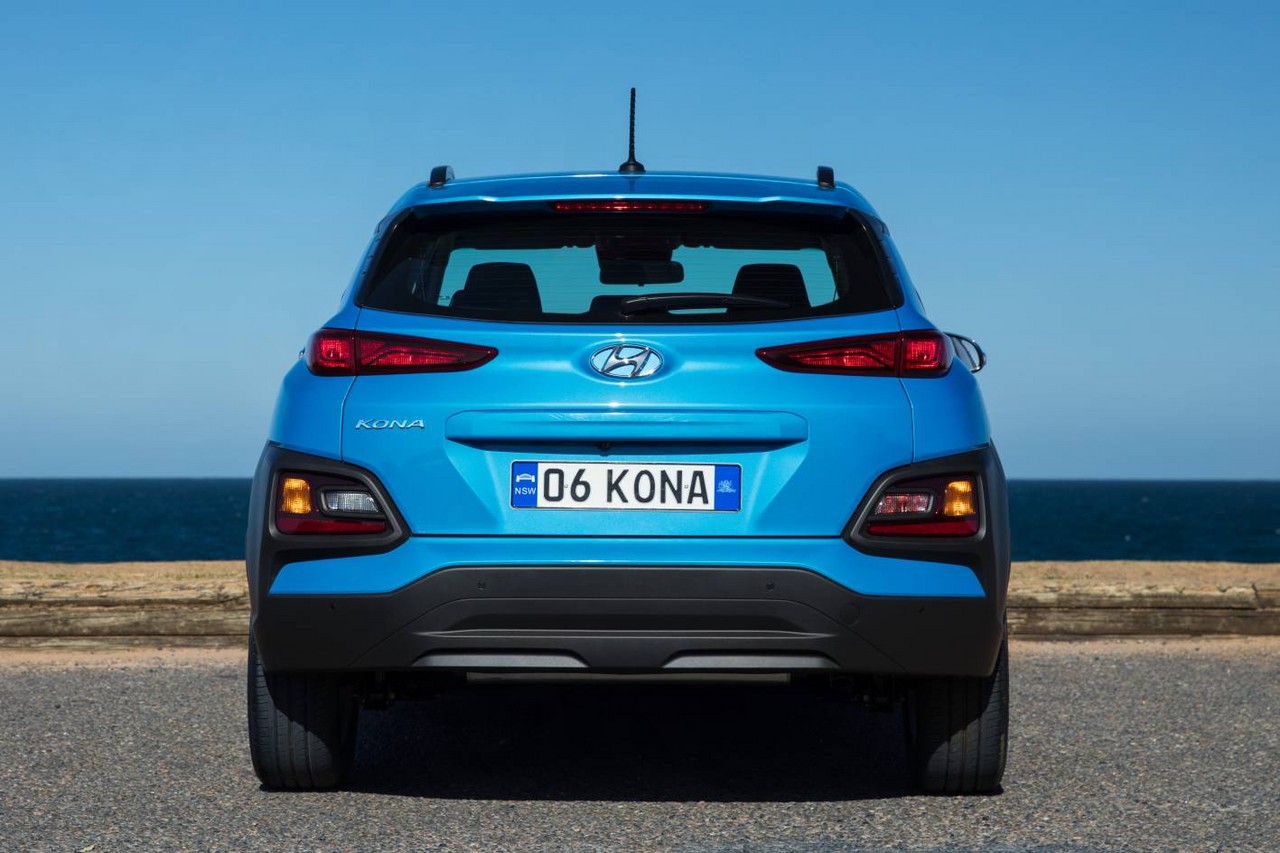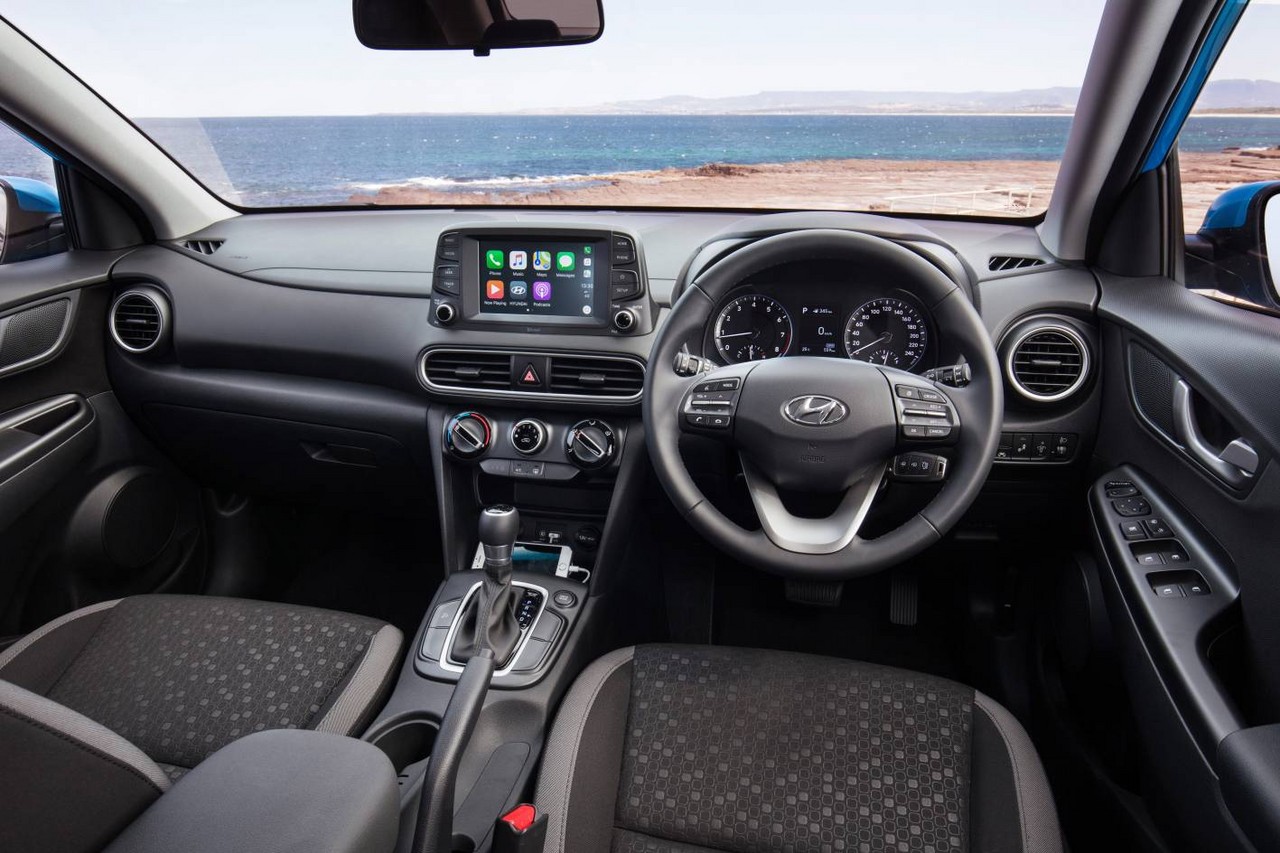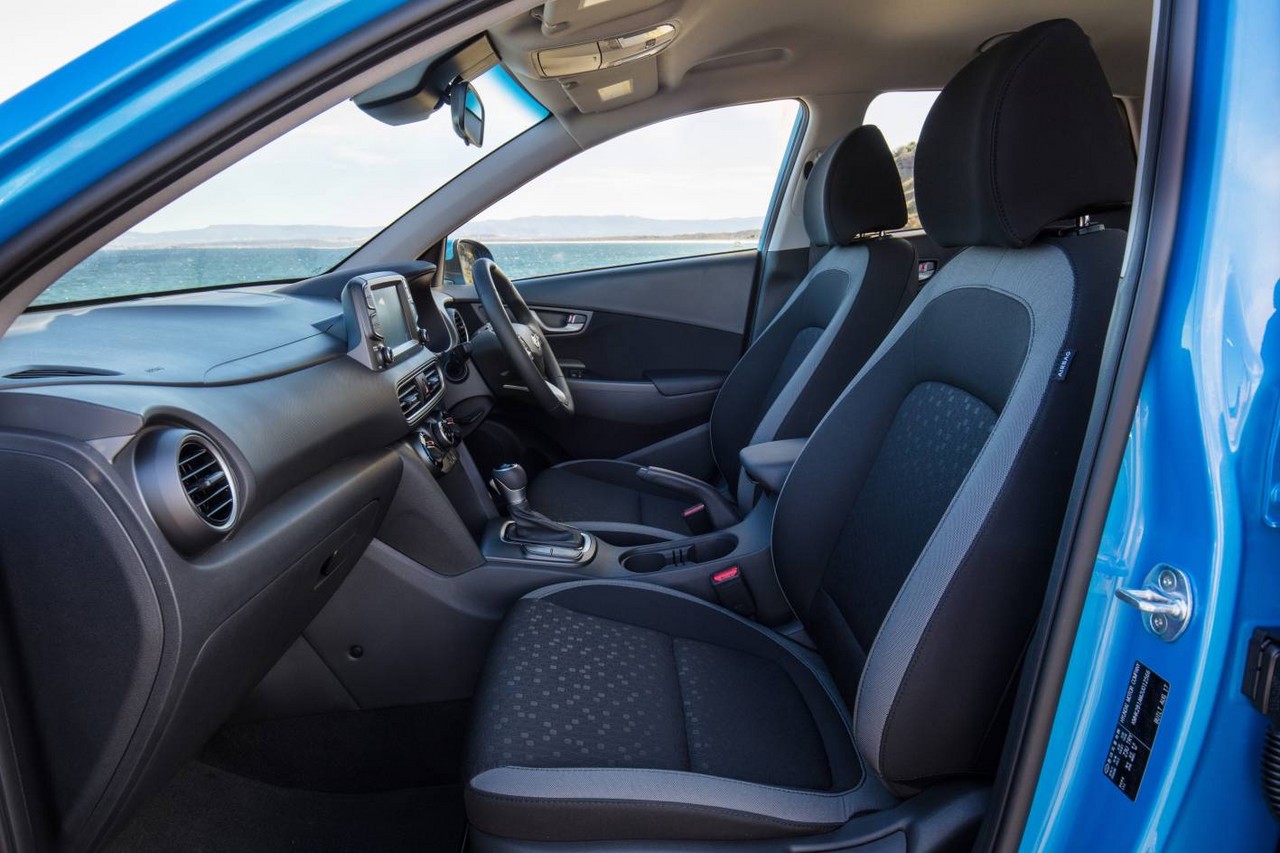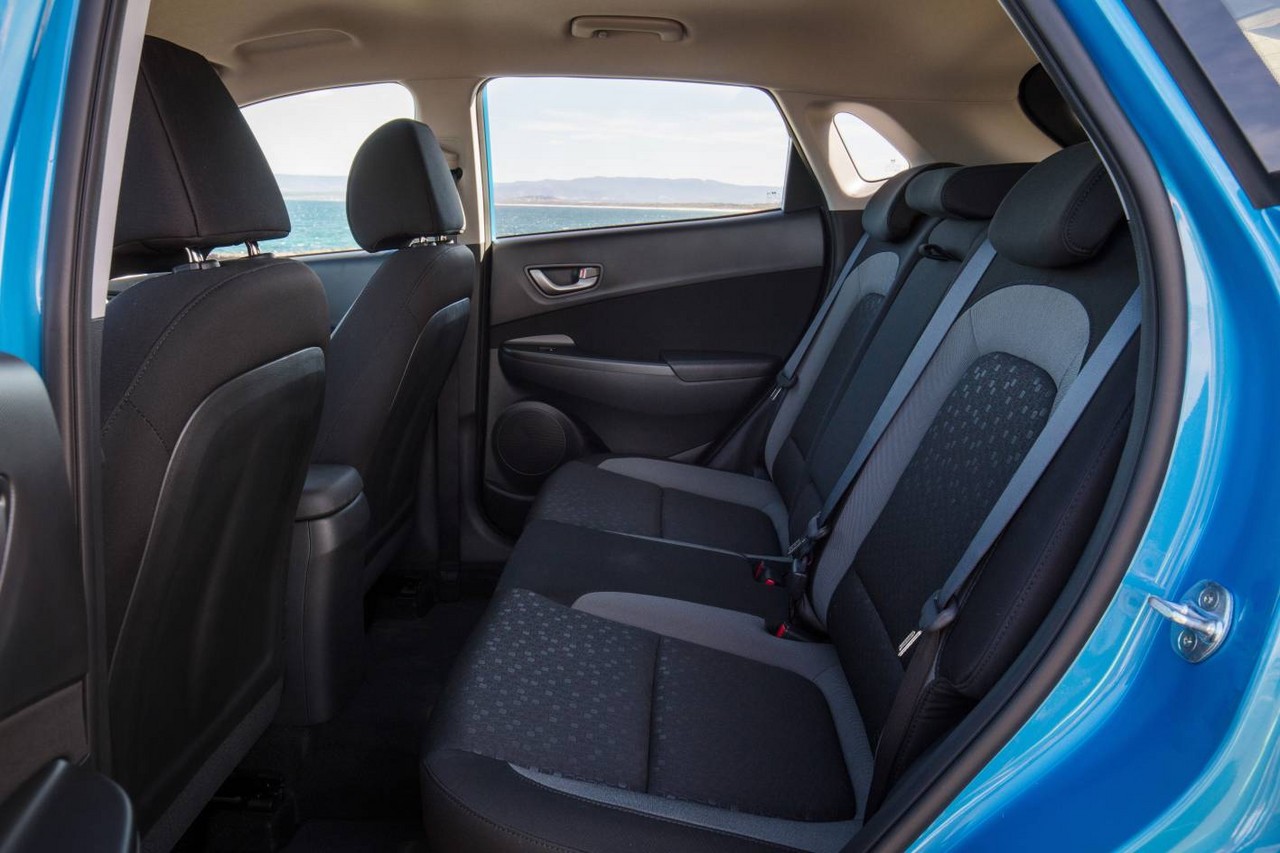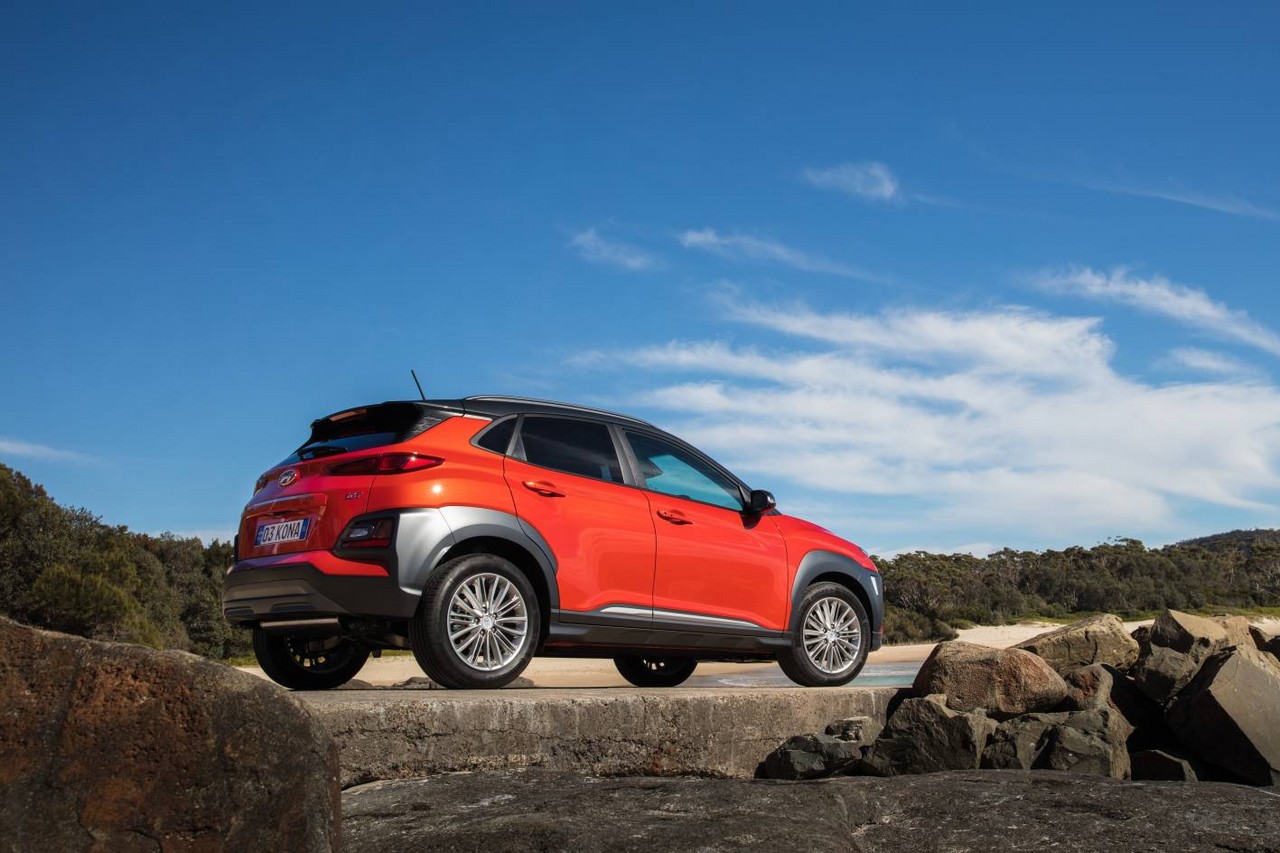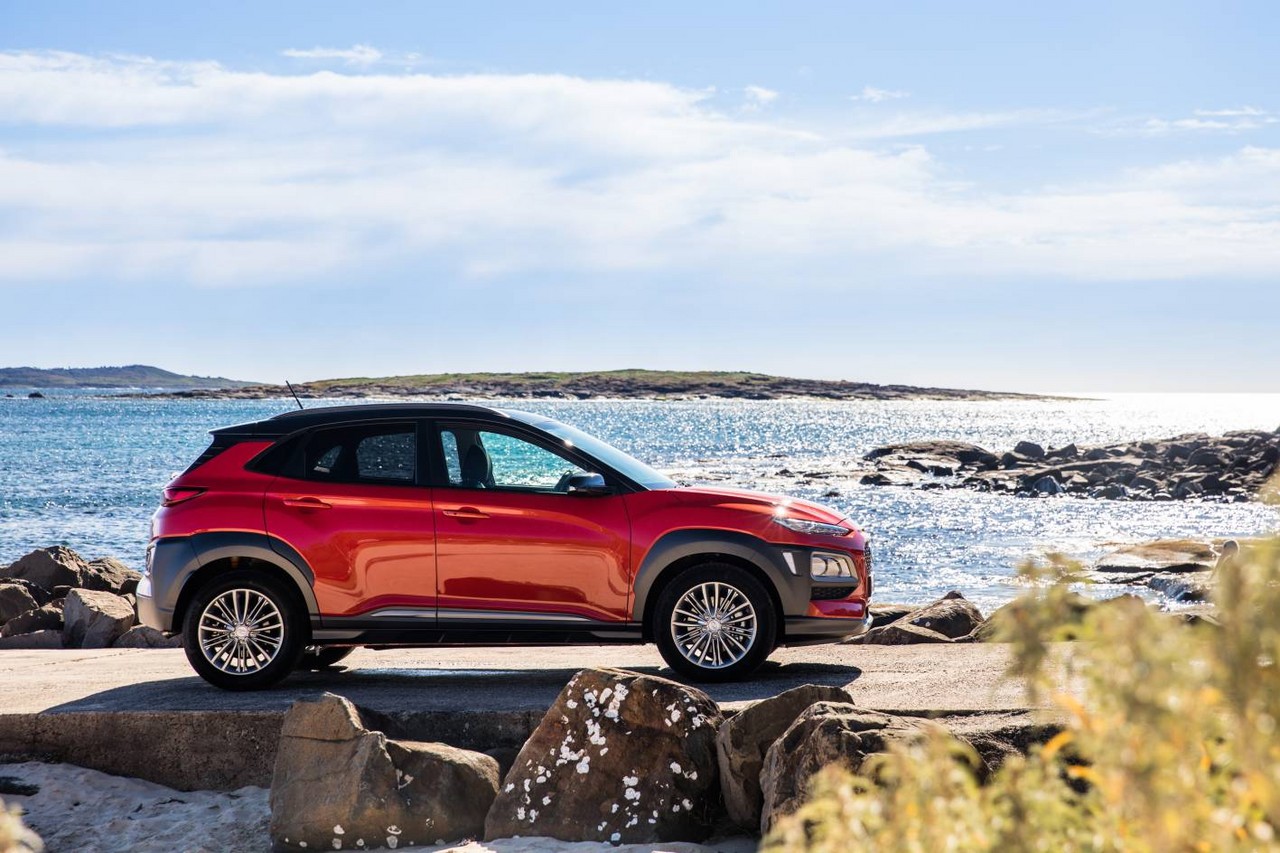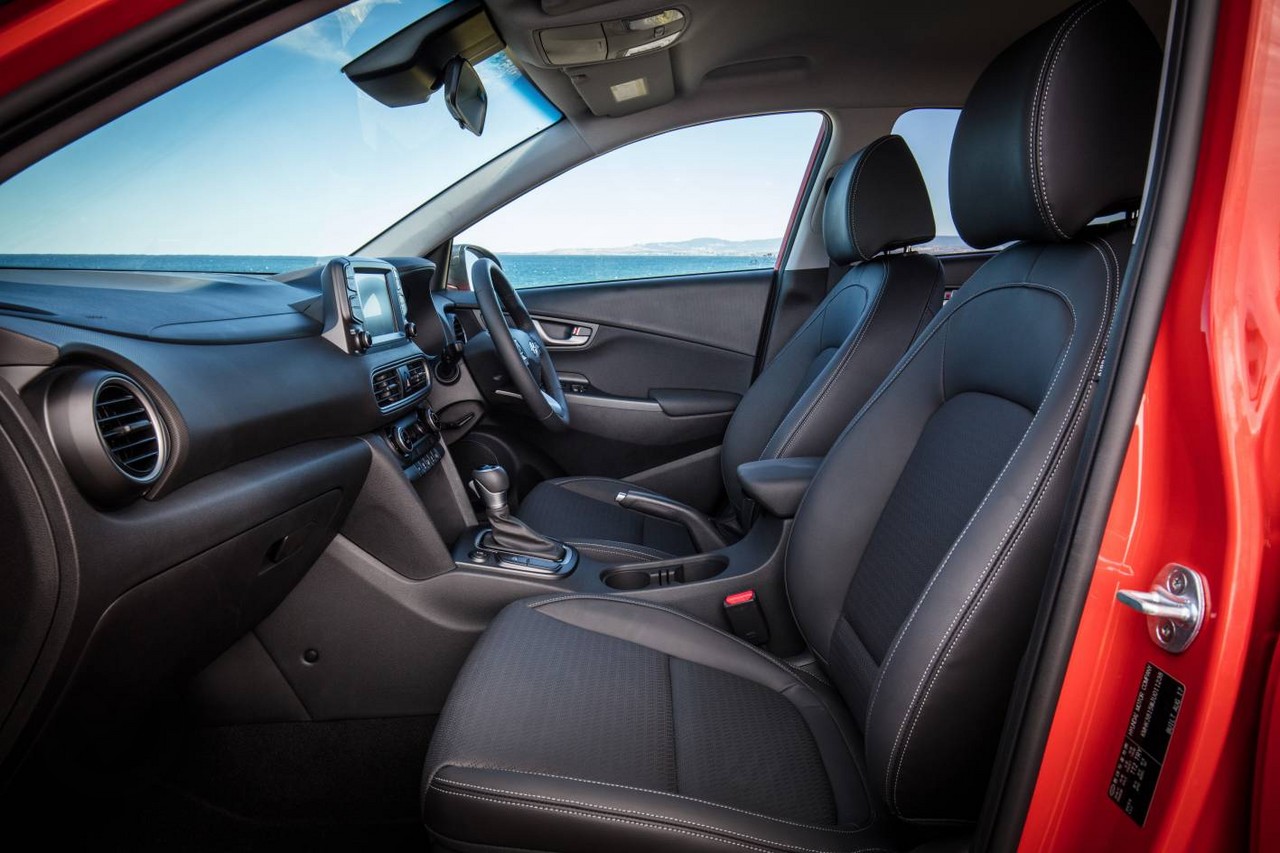
- Responsive 1.6-litre turbocharged petrol engine
- Platform makes extensive use of advanced high strength steels (AHSS)
- Accomplished ride/handling balance for turbocharged models with IRS…
- … though inferior suspension compliance for models with torsion beam rear suspension
- AEB not standard across the range
- Cramped rear seat
- Tyre noise
- Cheap interior plastics
- For DCT, jerky gearshifts at low speeds
- Poor quality sound system
Overview
Released in Australia in October 2017, the Hyundai OS Kona was a compact SUV. Manufactured in Ulsan, South Korea, the Hyundai OS Kona was offered in Australia with two powertrains:
- A 2.0-litre naturally aspirated petrol engine that drove the front wheels via a six-speed automatic transmission; and,
- A 1.6-litre turbocharged petrol engine that had an all-wheel drive system and a seven-speed double clutch transmission (DCT).
For Australia, the Hyundai Kona range initially consisted of Active, Elite and Highlander editions. In August 2018, however, the Hyundai Kona range was expanded with the release of a ‘Go’ edition. The Kona Active, Elite and Highlander editions were also equipped with additional features from August 2018 (see ‘August 2018 changes’, below).
| Variant | Edition | Engine | Trans. | Peak power | Peak torque |
|---|---|---|---|---|---|
| 2.0 MPI | Go, Active, Elite, Highlander |
2.0-litre G4NH ‘Nu’ petrol I4 | 6sp auto | 110 kW at 6200 rpm | 180 Nm at 4500 rpm |
| 1.6 T-GDI AWD | Go, Active, Elite, Highlander |
1.6-litre G4FJ ‘Gamma’ turbo petrol I4 | 7sp DCT | 130 kW at 5500 rpm | 265 Nm at 1500-4500 rpm |
All-wheel drive system
The Hyundai OS Kona 1.6 T-GDI had an on-demand all-wheel drive system. In normal conditions, the engine’s torque was primarily directed to the front wheels. In the event that there was a loss of traction, or such a loss was anticipated, clutch plates within the multi-plate clutch would engage to direct up to 50 per cent of the engine’s torque to the rear wheels (i.e. a 50:50 front:rear torque split).
Body and dimensions
While the Hyundai Kona was underpinned by a new platform that was developed for compact SUVs and shared with the Kia Stonic (not available in Australia), AustralianCar.Reviews understands that the platform was related to that which underpinned the Hyundai PD i30 . According to Hyundai, 51.8 per cent of the body consisted of advanced high strength steel (AHSS) and 114.5 metres of structural adhesive was used to bond components.
The Hyundai OS Kona was 4165 mm long, 1800 mm wide, 1565 mm tall (including standard fit roof rails) and had a 2600 mm long wheelbase; ground clearance was 170 mm. The Kona had a luggage capacity of 361 litres with the rear seats in position, though this increased to 1143 litres when the rear seats were folded down.
Suspension and steering
The Hyundai Kona had MacPherson strut front suspension, though the rear suspension depended on drive type since
- Front-wheel drive models had a coupled torsion beam rear axle; and,
- All-wheel drive models had multi-link rear suspension with dual lower arms.
The Hyundai Kona had rack-and-pinion steering with electric power assistance (Hyundai’s ‘Column mounted Motor Driven Power Steering’, or C-MDPS). The steering wheel required 2.5 turns from lock to lock, while the Hyundai Kona had a turning circle of 10.6 metres.
For Australia, the suspension and steering of the Hyundai Kona had a unique tune for local conditions. While the suspension of the Kona 2.0 MPI was tuned for comfort, the suspension for the Kona 1.6 T-GDI had a greater emphasis on handling.
Safety equipment
Standard safety equipment for the Hyundai Kona included dual front airbags, front seat-mounted side airbags, full-length curtain airbags, ABS, electronic brake force distribution, brake assist, electronic stability control, traction control and front seatbelts with pre-tensioners and load limiters.
The Hyundai Kona Elite and Highlander were further equipped with the following active safety technologies –
- Forward Collision Warning (FCW): operating at speeds from 8 km/h to 64 km/h for pedestrian detection and up to 160 km/h for vehicle detection, FCW used front radar and camera sensors to detect frontal collision risks. If there was a risk of a frontal collision, the driver would be alerted by visual and acoustic warnings;
- Forward Collision-Avoidance Assist (FCA): if the collision risk persisted after the Forward Collision Warning (FCW), the braking system would be prepared so that it would respond faster when the brakes were applied. When a collision was assessed to be unavoidable, maximum braking force would be applied (i.e. autonomous emergency braking or AEB) to reduce vehicle speed and the severity of the collision;
- Lane Keeping Assist System (LKAS): operating at speeds over 60 km/h, LKAS monitored the vehicle’s position relative to lane markings and provided visual and acoustic warnings if the Kona was about to cross over white, grey and blue lines or Bott’s dots on the road. Corrective steering would then be initiated to guide the vehicle back to a safe position within its lane;
- Driver Attention Warning (DAW): operating at speeds from 60 km/h to 180 km/h, DAW monitored steering angle, steering torque and the vehicle’s position within its lane to detect inattentive or fatigued driving. If detected, the driver was alerted via an audible tone and a message that suggested they take a break;
- Blind-Spot Collision Warning (BCW): operating at speeds above 30 km/h, BCW used radar sensors to monitor the rear corners of the Hyundai Kona and, if another vehicle was detected, a visual alert would appear in the relevant exterior mirror. If the driver then activated the indicators, an audible signal would be emitted; and,
- Rear Cross-Traffic Collision Warning (RCCW): using the rear radar sensors to scan a 180-degree area behind the vehicle, RCCW operated when the Kona was reversing to detect approaching traffic that may cross the driver’s path. If detected, the driver would receive visual and audible warnings.
For the Hyundai Kona Go and Active, these active safety technologies were available in an extra-cost ‘Safety Pack’ ($1500 at launch).
From August 2019, the Kona Go and Active editions were fitted – as standard – with:
- A camera-based Forward Collision-Avoidance (FCA) City/Urban system with Forward Collision Warning (FCW);
- Lane Keeping Assist System (LKAS); and,
- Driver Attention Warning (DAW).
From August 2019, the Kona Elite and Highlander were equipped with Hyundai’s ‘Smart Cruise Control’ (SCC) which used the front radar sensor to detect the speed and distance of vehicles ahead of the Kona. SCC would then maintain a safe distance to that vehicle, up to the cruising speed – between 30 km/h and 180 km/h – set by the driver. If the vehicle ahead came to a stop, SCC would slow the vehicle to 10 km/h before prompting the driver to take control.
Euro NCAP testing
In Euro NCAP testing , the 2017 Hyundai Kona received a five star safety rating which included an 87 per cent adult occupant protection rating, an 85 per cent child occupant protection rating and a 60 per cent ‘safety assist’ rating based on the Speed Assistance and Lane Assist systems being fitted as standard (though this was not the case for Australian-delivered vehicles).
In the frontal offset test, protection of both front occupants was generally rated as good, though protection of the driver’s lower legs was rated as adequate (i.e. a slight risk of serious injury). While maximum points were awarded in the side impact test, protection of the driver’s chest in the more severe pole test was rated as adequate.
Under ANCAP’s rating system , the Hyundai Kona received a five star safety rating with an overall score of 35.07 out of 37.
Brakes
The Hyundai Kona 2.0 MPI had 280 mm by 23 mm ventilated front brake discs and 262 mm by 10 mm solid rear discs. The Kona 1.6 T-GDI, however, had 305 mm by 25 mm ventilated front brake discs and 284 mm by 10 mm solid rear discs.
Features: Hyundai Kona Active and Go
The standard infotainment for the Hyundai Kona consisted of a six speaker sound system, an AM/FM radio, auxiliary (3.5 mm) and USB inputs, Bluetooth mobile phone connectivity and audio streaming, and a seven-inch touchscreen. For smartphone integration, the Hyundai Kona was equipped with Apple CarPlay and Android Auto. The Kona was also equipped with Hyundai’s ‘Auto Link’ which could connect the Kona’s on-board computer to a mobile device via Bluetooth to provide real-time vehicle diagnostics (including tyre pressure monitoring and ‘health-check’ status), driving history statistics, parking management, service scheduling and access to roadside assistance.
Standard features for the pre-August 2018 Kona Active and Kona Go included 16 x 6.5J alloy wheels with 205/60 R16 tyres, air conditioning, cruise control, projector beam headlights with dusk-sensing function, LED daytime running lights, LED positioning lights, a rear fog light, rear parking sensors, a rear view camera with dynamic guide lines, a leather-wrapped steering wheel and gear knob, 60:40 split folding rear seats, remote central locking, power adjustable door mirrors, power windows, tilt and telescopic steering wheel adjustment, a height adjustable driver’s seat, two 12 volt power outlets, tyre pressure monitoring system (TPMS), a 3.5-inch instrument cluster LCD with digital speedometer and trip computer, roof rails, an alarm and immobiliser.
Beyond this, the Hyundai Kona Active with Safety Pack added heated door mirrors which had an automatic folding function.
Features: Hyundai Kona Elite
Compared to the Kona Active with Safety Pack, the Kona Elite was further equipped with 17 x 7.0J alloy wheels with 215/55 R17 tyres, single-zone climate control air conditioning, leather seats, front fog lights, rain-sensing wipers, proximity key (i.e. keyless entry), push-button start, front seatback pockets, a luggage net, solar control glass and rear privacy glass.
Visually, the Hyundai Kona Elite and Highlander could be identified by their chrome front grille surrounds, carbon grey grilles, silver side garnishes and rear silver skid plates.
Features: Hyundai Kona Highlander
The range-topping Hyundai Kona Highlander was distinguished by its 18 x 8.5J alloy wheels with 235/45 R18 tyres, ventilated and heated front seats, ten-way power adjustable driver’s seat, an eight-way power adjustable front passenger seat, LED headlights (low and high beam), LED rear combination lights, front parking sensors, a head-up display (HUD), heated steering wheel, electrochromatic rear view mirror, wireless mobile phone charging pad (Qi standard) and 4.2-inch instrument cluster colour LCD.
Unique within the range, the Kona Highlander was also equipped with High Beam Assist (HBA). Operating at speeds above 46 km/h in its ‘Auto’ mode, HBA used a windscreen-mounted camera to detect oncoming vehicles and vehicles in the same lane. If detected, HBA would switch to low-beam headlights to avoid dazzling other drivers. When vehicles were no longer detected, the system would revert to high beam headlights for greater visibility.
August 2018 changes
With the release of the Hyundai Kona Go in August 2018, standard features were extended to include a USB port in the centre console recess which could be used to charge mobile devices. Beyond this, the Hyundai Kona Active, Elite and Highlander gained an eight-inch touch screen (previously seven-inch), satellite navigation (not previously available) and a Krell audio system which had eight speakers and a digital radio tuner (DAB+). The Kona Highlander was also fitted with a power-operated glass sunroof.
2019 Hyundai Kona 1.6 T-GDi Iron Man Edition
The Hyundai Kona 1.6 T-GDi AWD Iron Man Edition was released in Australia in March 2019. Visually, the Kona Iron Man Edition could be identified by its matte grey and ‘Iron Man red’ paint finish, ‘Iron-grip’ dual-tone 18-inch alloy wheels, ‘Iron Man’ emblems on the front guards and projection through puddle lamps, and red bonnet bezel with Marvel logo.
For the interior of the Hyundai Kona Iron Man Edition,
- The leather seats had red stitching and piping;
- The heated and ventilated front seats had a stitched ‘Stark Industries’ logo and ‘Iron Man’ image on the backrests;
- The eight-inch touch screen and instrument cluster had an Iron Man-themed graphical interface;
- A character themed welcome animation was displayed on the instrument cluster and head-up display (HUD);
- The instrument cluster and tachometer had a Stark Industries Arc Reactor for the background graphics; and,
- The dashboard had a Tony Stark signature.
Upon its release, the Hyundai Kona Iron Man Edition had a recommended retail price of $39,990 (excluded on-road costs).
Specifications
